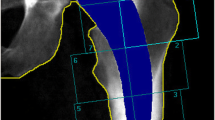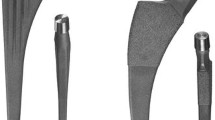Abstract
Purpose
The purpose of this study was to examine potential differences between patients under and over 60 years who underwent a total short hip stem arthroplasty in a 24-month follow-up in a clinical setting.
Methods
Sixty seven patients were included in this prospective study and divided in two groups. In the younger cohort 39 patients ≤ 59 years and in the older cohort 28 patients ≥ 60 years were included. Clinical and radiological examinations of the patients took place preoperatively, postoperatively and after 3, 6, 12 and 24 months. The Harris Hip Score (HHS) was raised as clinical examination. Changes of bone mass density (BMD), stress shielding, reactive lines, spot welds and sclerosing were examined as radiological analysis.
Results
The HHS improved from 53.6 ± 8.2 preoperative to 93.2 ± 9.6 in the younger cohort and for the older cohort from 57.6 ± 14.8 to 94.1 ± 7.6 after 24 months. BMD growth was detectable in regions of interest (ROI) 3 and 6 for both groups. Different results between the cohorts could only be detected in ROIs 4 and 5. The older cohort showed a loss of BMD of 5.95% in ROI 4 and 3.17% in ROI 5 after 24 months, whereas the younger cohort showed no loss of BMD in both ROIs.
Conclusions
No significant differences or any influences of osseointegration and clinical outcome of the short hip stem for both groups were detectable. Lower losses (ROIs 1 and 2) and higher growths (ROIs 3, 4, 5) were discovered in younger patients and the HHS improved in both groups. Reasons for this result could be age, sex or the level of activity of the patients, but in both groups the short hip stem shows comparable results in clinical as well as in radiological examination. We conclude that the short hip stem seems to be an adequate treatment also for older patients.

Similar content being viewed by others
References
Lewinski G von, Floerkemeier T (2015) 10-year experience with short stem total hip arthroplasty. Orthopedics 38(3 Suppl):S51–S56. https://doi.org/10.3928/01477447-20150215-57
National Center for Health Statistics NCHS Data Brief, Number 186, February 2015
Thorey F, Hoefer C, Abdi-Tabari N et al (2013) Clinical results of the metha short hip stem: a perspective for younger patients? Orthop Rev (Pavia) 5(4):e34. https://doi.org/10.4081/or.2013.e34
Kim Y-H, Park J-W, Kim J-S (2016) Metaphyseal Engaging Short and Ultra-Short Anatomic Cementless Stems in Young and Active Patients. J Arthroplasty 31(1):180–185. https://doi.org/10.1016/j.arth.2015.07.029
Bottai V, Dell’Osso G, Celli F et al (2015) Total hip replacement in osteoarthritis: the role of bone metabolism and its complications. Clin Cases Miner Bone Metab 12(3):247–250. https://doi.org/10.11138/ccmbm/2015.12.3.247
Warming L, Hassager C, Christiansen C (2002) Changes in bone mineral density with age in men and women: a longitudinal study. Osteoporos Int 13(2):105–112. https://doi.org/10.1007/s001980200001
Jones G, Nguyen T, Sambrook P et al (1994) Progressive loss of bone in the femoral neck in elderly people: longitudinal findings from the Dubbo osteoporosis epidemiology study. BMJ 309(6956):691–695
Schnurr C, Loucif A, Patzer T et al (2018) Short stem survival after osteonecrosis of the femoral head. Arch Orthop Trauma Surg 138(4):573–579. https://doi.org/10.1007/s00402-018-2892-2
Mancuso CA, Sculco TP, Salvati EA (2003) Patients with poor preoperative functional status have high expectations of total hip arthroplasty. J Arthroplasty 18(7):872–878
Wohlrab D, Hagel A, Hein W (2004) Vorteile der minimalinvasiven Implantation von Hüfttotalendoprothesen in der frühen postoperativen Rehabilitationsphase (Advantages of minimal invasive total hip replacement in the early phase of rehabilitation). Z Orthop Ihre Grenzgeb 142(6):685–690. https://doi.org/10.1055/s-2004-832447
Kurtz SM, Ong KL, Schmier J et al (2009) Primary and revision arthroplasty surgery caseloads in the United States from 1990 to 2004. J Arthroplasty 24(2):195–203. https://doi.org/10.1016/j.arth.2007.11.015
Bovonratwet P, Malpani R, Ottesen TD et al (2018) Aseptic revision total hip arthroplasty in the elderly: Quantifying the risks for patients over 80 years old. Bone Joint J 100-B(2): 143–151. https://doi.org/10.1302/0301-620X.100B2.BJJ-2017-0895.R1
Jahnke A, Engl S, Altmeyer C et al (2014) Changes of periprosthetic bone density after a cementless short hip stem: a clinical and radiological analysis. Int Orthop 38(10):2045–2050. https://doi.org/10.1007/s00264-014-2370-6
Frndak PA, Mallory TH, Lombardi AV (1993) Translateral surgical approach to the hip. The abductor muscle “split”. Clinical Orthopaedics and Related Research(295): 135–141
Bauer R, Kerschbaumer F, Poisel S et al (1979) The Transgluteal Approach to the Hip Joint. Arch Orthop Traumat Surg 95(1–2):47–49. https://doi.org/10.1007/BF00379169
Thomas A, Gruen GM, McNeice, Harlan C, Amstutz (1979) Modes of Failure of Cemented STem-type Femoral Components. Clinical Orthopaedics and Related Research(141): 17–27
Zimmer EA, Zimmer-Brossy M (1979) Hüftgelenk: axial nach Lauenstein. In: Zimmer EA, Zimmer-Brossy M (eds) Röntgen-Fehleinstellungen: Erkennen und Vermeiden. Springer, Berlin, pp 135–137
Engh CA, Massin P, Suthers KE (1990) Roentgenographic assessment of the biologic fixation of porous-surfaced femoral components. Clinical Orthopaedics and Related Research(257): 107–128
Wittenberg RH, Steffen R, Windhagen H et al (2013) Five-year results of a cementless short-hip-stem prosthesis. Orthop Rev (Pavia) 5(1):e4. https://doi.org/10.4081/or.2013.e4
Chammaï Y, Brax M (2015) Medium-term comparison of results in obese patients and non-obese hip prostheses with Metha® short stem. Eur J Orthop Surg Traumatol 25(3):503–508. https://doi.org/10.1007/s00590-014-1574-1
Söderman P, Malchau H (2001) Is the Harris hip score system useful to study the outcome of total hip replacement? Clinical Orthopaedics and Related Research(384): 189–197
Acklin YP, Jenni R, Bereiter H et al (2016) Prospective clinical and radiostereometric analysis of the Fitmore short-stem total hip arthroplasty. Arch Orthop Trauma Surg 136(2):277–284. https://doi.org/10.1007/s00402-015-2401-9
Kutzner KP, Freitag T, Donner S et al (2017) Outcome of extensive varus and valgus stem alignment in short-stem THA: clinical and radiological analysis using EBRA-FCA. Arch Orthop Trauma Surg 137(3):431–439. https://doi.org/10.1007/s00402-017-2640-z
Martini F, Schmidt B, Sell S (1997) Wertigkeit und Reproduzierbarkeit osteodensitometrischer DEXA-Messungen nach Hüfttotalendoprothesenimplantation (Validity and reproducibility of osteodensitometric DEXA-measurements following total hip endoprosthesis). Z Orthop Ihre Grenzgeb 135(1):35–39. https://doi.org/10.1055/s-2008-1039552
Panisello JJ, Herrero L, Herrera A et al (2006) Bone remodelling after total hip arthroplasty using an uncemented anatomic femoral stem: a three-year prospective study using bone densitometry. J Orthop Surg (Hong Kong) 14(1):32–37. https://doi.org/10.1177/230949900601400108
Brodner W, Bitzan P, Lomoschitz F et al (2004) Changes in bone mineral density in the proximal femur after cementless total hip arthroplasty. A five-year longitudinal study. J Bone Joint Surg Br 86(1):20–26
Korovessis P, Droutsas P, Piperos G et al (1997) Course of bone mineral content changes around cementless Zweymueller total hip arthroplasty. A 4-year follow-up study. Arch Orthop Trauma Surg 116(1–2):60–65
Sköldenberg OG, Bodén HSG, Salemyr MOF et al (2006) Periprosthetic proximal bone loss after uncemented hip arthroplasty is related to stem size: DXA measurements in 138 patients followed for 2–7 years. Acta Orthop 77(3):386–392. https://doi.org/10.1080/17453670610046307
Jones CA, Voaklander DC, Johnston DW et al (2001) The effect of age on pain, function, and quality of life after total hip and knee arthroplasty. Arch Intern Med 161(3):454–460
Santaguida PL, Hawker GA, Hudak PL et al (2008) Patient characteristics affecting the prognosis of total hip and knee joint arthroplasty: a systematic review. Can J Surg 51(6):428–436
Fang M, Noiseux N, Linson E et al (2015) The Effect of Advancing Age on Total Joint Replacement Outcomes. Geriatr Orthop Surg Rehabil 6(3):173–179. https://doi.org/10.1177/2151458515583515
Freitag T, Hein M-A, Wernerus D et al (2016) Bone remodelling after femoral short stem implantation in total hip arthroplasty: 1-year results from a randomized DEXA study. Arch Orthop Trauma Surg 136(1):125–130. https://doi.org/10.1007/s00402-015-2370-z
Lerch M, Haar-Tran A von der, Windhagen H et al (2012) Bone remodelling around the Metha short stem in total hip arthroplasty: a prospective dual-energy X-ray absorptiometry study. Int Orthop 36(3):533–538. https://doi.org/10.1007/s00264-011-1361-0
Albanese CV, Santori FS, Pavan L et al (2009) Periprosthetic DXA after total hip arthroplasty with short vs. ultra-short custom-made femoral stems: 37 patients followed for 3 years. Acta Orthop 80(3):291–297. https://doi.org/10.3109/17453670903074467
Gademan MGJ, Hofstede SN, Vliet Vlieland TPM et al (2016) Indication criteria for total hip or knee arthroplasty in osteoarthritis: a state-of-the-science overview. BMC Musculoskelet Disord 17. https://doi.org/10.1186/s12891-016-1325-z
Kobayashi S (2011) Whether bone quality matters or not in durability of total hip arthroplasty? Bone quality matters in durability of total hip arthroplasty. Clin Calcium 21(5):746–750
Author information
Authors and Affiliations
Corresponding author
Ethics declarations
Conflict of interest
The authors declare that they have no conflict of interest.
Rights and permissions
About this article
Cite this article
Boller, S., Jahnke, A., Augustin, L. et al. Age-related osseointegration of a short hip stem: a clinical and radiological 24 months follow-up. Arch Orthop Trauma Surg 139, 405–410 (2019). https://doi.org/10.1007/s00402-018-3082-y
Received:
Published:
Issue Date:
DOI: https://doi.org/10.1007/s00402-018-3082-y




